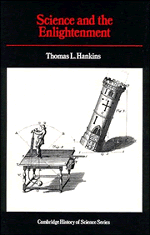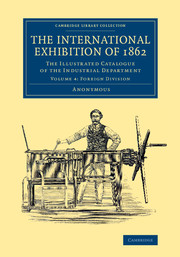Refine search
Actions for selected content:
13588 results in History of science and technology

Science and the Enlightenment
-
- Published online:
- 05 February 2015
- Print publication:
- 26 April 1985
Marjo Kaartinen, Breast Cancer in the Eighteenth Century. London: Pickering & Chatto, 2013. Pp. xii + 181. ISBN 978-1-84893-364-4. £60.00 (hardback).
-
- Journal:
- The British Journal for the History of Science / Volume 48 / Issue 1 / March 2015
- Published online by Cambridge University Press:
- 03 February 2015, pp. 177-178
- Print publication:
- March 2015
-
- Article
- Export citation
Far from depleted…
-
- Journal:
- The British Journal for the History of Science / Volume 48 / Issue 1 / March 2015
- Published online by Cambridge University Press:
- 03 February 2015, pp. 171-174
- Print publication:
- March 2015
-
- Article
- Export citation
Sharon M. Leon, An Image of God: The Catholic Struggle with Eugenics. London: The University of Chicago Press, 2013. Pp. ix + 226. ISBN 978-0-2260-3898-8. £31.50 (hardback).
-
- Journal:
- The British Journal for the History of Science / Volume 48 / Issue 1 / March 2015
- Published online by Cambridge University Press:
- 03 February 2015, pp. 185-187
- Print publication:
- March 2015
-
- Article
- Export citation
Angela Byrne, Geographies of the Romantic North: Science, Antiquarianism, and Travel, 1790–1830. Basingstoke: Palgrave Macmillan, 2013. Pp. ixv + 265. ISBN 978-1-137-31131-3. £55.00 (hardback).
-
- Journal:
- The British Journal for the History of Science / Volume 48 / Issue 1 / March 2015
- Published online by Cambridge University Press:
- 03 February 2015, pp. 180-181
- Print publication:
- March 2015
-
- Article
- Export citation
Michael Pettit, The Science of Deception: Psychology and Commerce in America. Chicago and London: The University of Chicago Press, 2013. Pp. 228. ISBN 978-0-226-92374-1. £35.00/$50.00 (hardback).
-
- Journal:
- The British Journal for the History of Science / Volume 48 / Issue 1 / March 2015
- Published online by Cambridge University Press:
- 03 February 2015, pp. 184-185
- Print publication:
- March 2015
-
- Article
- Export citation
Susan Schmidt Horning, Chasing Sound: Technology, Culture and the Art of Studio Recording from Edison to the LP. Baltimore: Johns Hopkins University Press, 2013. Pp. x + 292. ISBN 978-1-4214-1022-7. £29.00 (hardback).
-
- Journal:
- The British Journal for the History of Science / Volume 48 / Issue 1 / March 2015
- Published online by Cambridge University Press:
- 03 February 2015, pp. 187-188
- Print publication:
- March 2015
-
- Article
- Export citation
Thomas Kaiserfeld and Tom O'Dell (eds.), Legitimizing ESS: Big Science as a Collaboration across Boundaries. Lund: Nordic Academic Press, 2013. Pp. 240. ISBN 978-91-87351-10-5. £30.95 (hardback).
-
- Journal:
- The British Journal for the History of Science / Volume 48 / Issue 1 / March 2015
- Published online by Cambridge University Press:
- 03 February 2015, pp. 188-189
- Print publication:
- March 2015
-
- Article
- Export citation
André Holenstein, Hubert Steinke and Martin Stuber (eds.), Scholars in Action: The Practice of Knowledge and the Figure of the Savant in the 18th Century. 2 vols. Leiden: Brill, 2013. Pp. xxx + 501 and x + 425. ISBN 978-90-04-24390-3. €229.00 (hardback).
-
- Journal:
- The British Journal for the History of Science / Volume 48 / Issue 1 / March 2015
- Published online by Cambridge University Press:
- 03 February 2015, pp. 178-180
- Print publication:
- March 2015
-
- Article
- Export citation
Hasok Chang, Is Water H2O? Evidence, Realism and Pluralism. Heidelberg, London and New York: Springer, 2012. Pp. xxi + 316. ISBN 978-94-007-3931-4. £126.00 (hardback).
-
- Journal:
- The British Journal for the History of Science / Volume 48 / Issue 1 / March 2015
- Published online by Cambridge University Press:
- 03 February 2015, pp. 181-183
- Print publication:
- March 2015
-
- Article
- Export citation
Rob Boddice (ed.), Pain and Emotion in Modern History. Basingstoke: Palgrave Macmillan, 2014. Pp. xii + 284 ISBN: 978-1-137-37242-0. £65.00 (hardback). - Joanna Bourke, The Story of Pain: From Prayer to Painkillers. Oxford: Oxford University Press, 2014. Pp. xii + 396. ISBN: 978-0-19-968942-2. £20.00 (hardback).
-
- Journal:
- The British Journal for the History of Science / Volume 48 / Issue 1 / March 2015
- Published online by Cambridge University Press:
- 03 February 2015, pp. 191-193
- Print publication:
- March 2015
-
- Article
- Export citation
BJH volume 48 issue 1 Cover and Front matter
-
- Journal:
- The British Journal for the History of Science / Volume 48 / Issue 1 / March 2015
- Published online by Cambridge University Press:
- 03 February 2015, pp. f1-f2
- Print publication:
- March 2015
-
- Article
-
- You have access
- Export citation
Steven J. Dick, Discovery and Classification in Astronomy: Controversy and Consensus. New York: Cambridge University Press, 2013. Pp. xvi + 458. ISBN 978-1-107-03361-0. £30.00/$45.00 (hardback).
-
- Journal:
- The British Journal for the History of Science / Volume 48 / Issue 1 / March 2015
- Published online by Cambridge University Press:
- 03 February 2015, pp. 189-191
- Print publication:
- March 2015
-
- Article
- Export citation
BJH volume 48 issue 1 Cover and Back matter
-
- Journal:
- The British Journal for the History of Science / Volume 48 / Issue 1 / March 2015
- Published online by Cambridge University Press:
- 03 February 2015, pp. b1-b9
- Print publication:
- March 2015
-
- Article
-
- You have access
- Export citation
Marion Endt-Jones (ed.), Coral: Something Rich and Strange. Liverpool: Liverpool University Press, 2013. Pp. 128. ISBN 978-1-84631-959-4. £19.99 (paperback).
-
- Journal:
- The British Journal for the History of Science / Volume 48 / Issue 1 / March 2015
- Published online by Cambridge University Press:
- 03 February 2015, pp. 175-176
- Print publication:
- March 2015
-
- Article
- Export citation
Bernard Lightman and Michael S. Reidy (eds.), The Age of Scientific Naturalism: Tyndall and His Contemporaries. London: Pickering & Chatto, 2014. Pp. xv + 256. ISBN 978-1-84893-463-1. £60.00 (hardback).
-
- Journal:
- The British Journal for the History of Science / Volume 48 / Issue 1 / March 2015
- Published online by Cambridge University Press:
- 03 February 2015, pp. 183-184
- Print publication:
- March 2015
-
- Article
- Export citation

Description des expériences de la machine aérostatique de MM. de Montgolfier
- Et de celles auxquelles cette découverte a donné lieu
-
- Published online:
- 18 December 2014
- Print publication:
- 17 July 2014

The Steam Engine
- Comprising an Account of its Invention and Progressive Improvement
-
- Published online:
- 18 December 2014
- Print publication:
- 17 July 2014
- First published in:
- 1827

The International Exhibition of 1862
- The Illustrated Catalogue of the Industrial Department
-
- Published online:
- 18 December 2014
- Print publication:
- 17 April 2014
George Combe and common sense
-
- Journal:
- The British Journal for the History of Science / Volume 48 / Issue 2 / June 2015
- Published online by Cambridge University Press:
- 11 December 2014, pp. 233-259
- Print publication:
- June 2015
-
- Article
- Export citation
